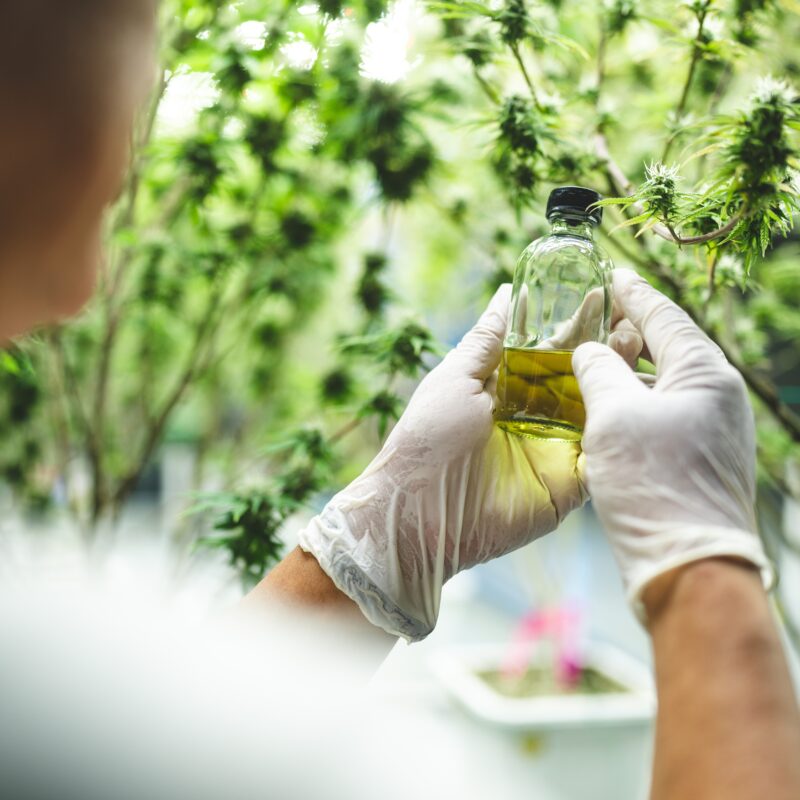CBD oil is currently utilized in a range of products including food, vitamins, and personal care items. BioGenesis provides a comprehensive selection of microbial testing services appropriate for CBD products. Here is a summary of some common microbial tests that adhere to AOAC International Methods.
CBD Products Testing

This test quantifies the total Aerobic Bacterial population in a sample through enumeration. While it does not identify specific bacteria, the resulting colony forming units (CFU) can be used to meet internal product acceptance criteria or for Environmental HACCP samples. This test is also valuable for assessing product freshness or confirming the effectiveness of sanitation procedures.
A minimum of 25 grams of sample is recommended for this test. Environmental surface samples can also be subjected to analysis.
Method: AOAC 990.12, 986.33, 989.10
Coliforms are commonly known as “indicator organisms.” While they are not usually harmful in themselves, their presence suggests that environmental conditions may support the growth of pathogens. Generic E. coli, a type of coliform of fecal origin, indicates fecal contamination when present in a sample. The Total Coliform/E. coli test offers a quick, cost-effective method to evaluate the cleanliness of an environment or food product and can provide insights into the likelihood of other types of contamination.
The data obtained from this test can be used to meet internal quality standards for products or Environmental HACCP samples. It also serves as an effective tool to assess product freshness or verify the efficacy of sanitation procedures. A minimum of 50 grams of sample is recommended for testing. Environmental surface samples can be analyzed as well.
Method: AOAC 991.14, 998.08
Listeria is an organism that is ubiquitous in the environment. Unlike some other food related pathogens, it is not disseminated from animals. For high-risk populations (the very old, the very young, pregnant and immunocompromised) a very small amount of Listeria in food can be highly dangerous. Listeria monocytogenes is the most pathogenic of the species.
L. monocytogenes has been associated with such foods as raw milk, supposedly pasteurized fluid milk, cheeses (particularly soft-ripened varieties), ice cream, raw vegetables, fermented raw-meat sausages, raw and cooked poultry, raw meats (all types), and raw and smoked fish. Its ability to grow at temperatures as low as 3°C permits multiplication in refrigerated foods and on environmental surfaces.
The method detects the Presence or Absence of the bacterium. A confirmation charge may be incurred in cases of Presumptive Positive screens. 50g minimum sample is recommended. Environmental surface samples can also be analyzed. Listeria can be speciated upon request.
Method: AOAC 2013.10
Salmonella is commonly found in animals, particularly in poultry and pigs. The bacterium can also be found in various environmental sources such as water, soil, insects, factory and kitchen surfaces, and animal feces. It is present in raw meats, poultry, seafood, and other foods such as eggs, dairy products, fish, shrimp, frog legs, yeast, coconut, sauces, salad dressings, cake mixes, cream-filled desserts, dried gelatin, peanut butter, cocoa, and chocolate, which have all been linked to Salmonella outbreaks.
Individuals of all ages are at risk, but the elderly, infants, and those with weakened immune systems experience more severe symptoms. Patients with AIDS are particularly vulnerable, experiencing salmonellosis about 20 times more frequently than the general population and often suffering recurrent episodes.
These methods determine whether the bacterium is present or absent. A fee for confirmation may be applied if the initial screen suggests a presumptive positive result. A minimum of 50 grams is recommended for sample submission or an environmental sponge.
Methods: AOAC 2013.01
A taxonomically defined family, Enterobacteriaceae, is comprised of several genera of bacteria including: Citrobacter, Enterobacter, Erwinia, Escherichia, Klebsiella, Proteus, Salmonella, Shigella, and Yersinia. This group has been used for years in Europe as indicators of food quality and as indices of food safety. The practice is also being adopted in the United States.
50g minimum sample is recommended. Environmental surface samples can also be analyzed.
Method: AOAC 2003.01
This test quantifies the total yeast and mold population in a sample, though it does not identify specific types.
Yeast and mold are responsible for various levels of food spoilage and decomposition. They can grow on almost any food type and at any stage, including on crops like grains, nuts, beans, and fruits, whether in the field, during harvest, or while in storage. They also affect processed foods and food mixtures. The extent of contamination varies depending on the type of food, the organisms involved, and the level of invasion. Affected food might show minor blemishes, severe blemishes, or be completely decomposed. Signs of growth include rot spots of different sizes and colors, unsightly scabs, slime, white cottony mycelium, or brightly colored sporulating mold. Contaminated foods may also develop off-flavors and odors. In some cases, foods that appear mold-free might still be contaminated upon closer mycological examination. The presence of yeasts and molds in foods can lead to significant economic losses for producers, processors, and consumers.
A minimum of 50 grams of sample is recommended for this test. Environmental surface samples can be tested as well.
Method: AOAC 997.02 AOAC 2014.05

